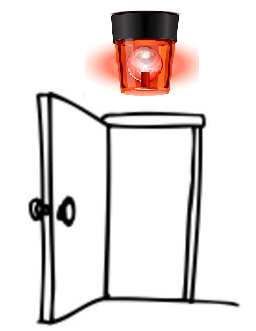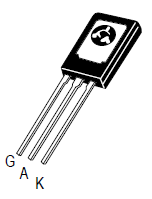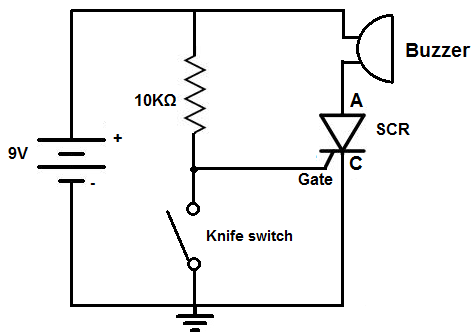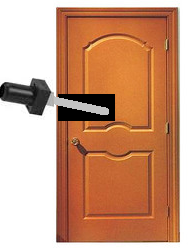How to Build a Door Alarm Circuit

In this project, we will go over how to build a door alarm circuit.
This is a circuit where an alarm will go off if the door that the circuit is connected to is opened.
When the door is ordinarily closed, the alarm is not triggered. When the door is opened up, the alarm goes off, alerting us that the door has been opened.
So this alarm circuit has really good practical use when we want to be alerted to when a door has opened.
Components Needed to Build Door Alarm Circuit
- Knife Switch
- C106B SCR
- 10KΩ Resistor
- Buzzer
- 9V Battery or DC power supply
The knife switch is the component which plays the variable role in this circuit. We will use a knife switch in our circuit. When the knife switch is closed, the alarm does not go off. When the knife switch is opened, the alarm does go off. This is the component that decides whether the alarm goes off or does not.
How a knife switch works is very simple.

When the knife switch is pressed down, electrical continuity is made across both sides and current can flow through the switch. When it is raised, no electrical continuity exists between the two ends and current cannot flow.
With the knife switch deciding if the alarm goes off in our circuit, the other significant component is the silicon-controlled rectifier (SCR).
The SCR is a 3-pin device
composed of a gate, an anode, and a cathode.

Like a transistor, when the SCR receives sufficient voltage at its gate terminal, it conducts across from anode to cathode. Without this voltage at its gate, no current can flow from anode to cathode. With this gate voltage, current can flow and power the load connected to the anode of the SCR. However, unlike a transistor, a SCR is different in that once it receives sufficient voltage at its gate, it conducts indefinitely from anode to cathode- unless power is disconnected from the anode. So while a transistor needs ongoing current at its base or gate terminal to conduct current across its junction, an SCR only needs to be triggered once to remain on. Thus, it acts like a latching circuit in that once it is turned on, it latches on and stays on.
Looking at the above SCR, with it turned to its back surface, the pin to the leftmost is the gate terminal, the middle pin is the anode, and the rightmost pin is its cathode.
This is the datasheet for the SCR: C106B SCR Datasheet.
For our circuit we will supply 9 volts DC to it. This 9VDC can be supplied either from a 9-volt battery
or a DC power supply.
Door Alarm Circuit Circuit
The schematic for the door alarm circuit is shown below:

We will use a knife switch in conjunction with a 10KΩ resistor- the 2 of these components form a voltage divider circuit. The 9 volts that are supplied to this circuit are in parallel with the 10KΩ resistor and the knife switch, with the gate of the SCR being connected to the middle of these 2 components.
This circuit should be mounted on a door so that the knife switch is right at the ledge of the door. The knob of the knife switch should extend across so that it goes past the ledge of the door.
Below is an example of a door with a knife switch mounted onto it.

You may have to get creative on how you mount this circuit to the door. You may use tape. Do whatever so that the knife switch is latched to the edge, so that it will become open when the door is opened.
When the door is closed, the knife switch makes electrical connection from the 10KΩ to ground. Because the knife switch is closed and makes electrical connection to ground, it represents a very low-resistance path for current. Remember that current always takes the path of least resistance. Since the closed knife switch has practically no resistance, current takes this path down to ground instead of through the gate of the SCR. Therefore, sufficient current does not go through the gate of the SCR to turn it on and the buzzer alarm does not go off.
When the door is opened, the knife switch goes from its closed position to an open position. By someone opening the door, the latch of the knife switch loses its connectivity with the circuit. The latch goes from closed to open. Now being that the knife switch is open and no longer has electrical continuity, it offers very high, practically infinite, resistance. With this high resistance, no current flows through the knife switch. Instead the current travels through the gate of the SCR, switching the SCR on. With the SCR on, the buzzer connected to the anode of the SCR turns on, setting off the alarm.
And this is how a door alarm can be created.
Different variations can be done for this circuit. If you don't want a buzzer to go off but instead want
something else to, swap out the buzzer for that component. You can add device that you want to go off once the SCR is
triggered. Customize the circuit to suit your preferences.
Related Resources
How to Build a Sound Alarm Circuit
How to Build a Heat Alarm Circuit
How to Build a Vibration Alarm Circuit
How to Build a Motion Detector Alarm Circuit
How to Build a Hall Effect Sensor Circuit
How to Build a Vibration Detector Circuit